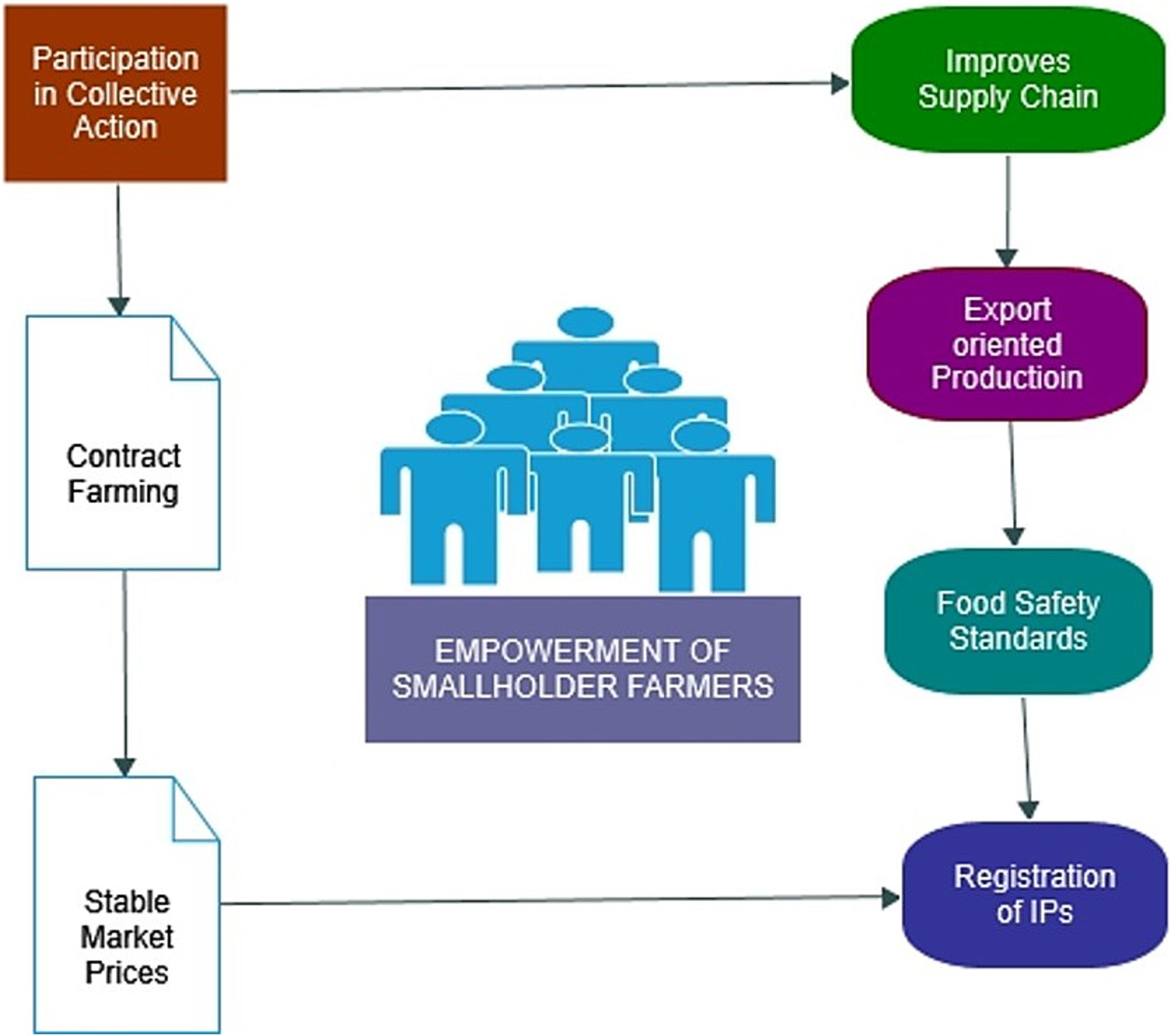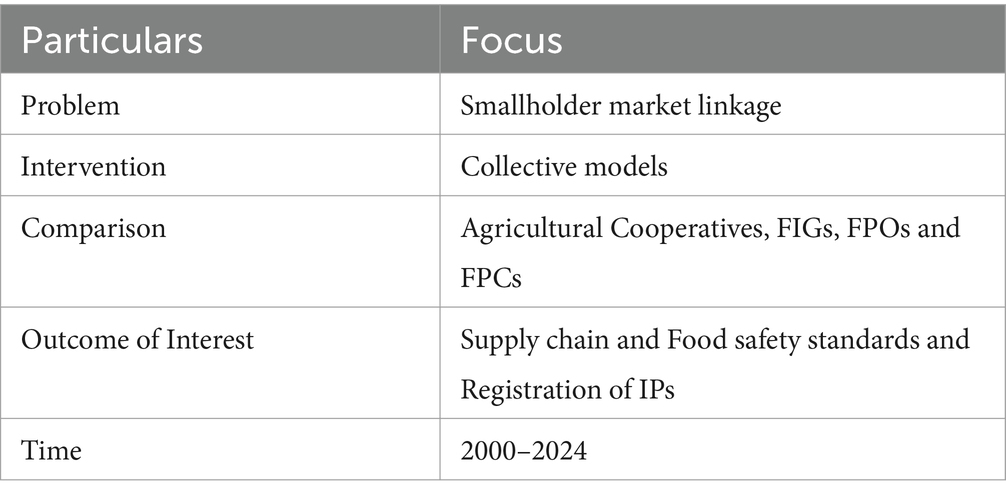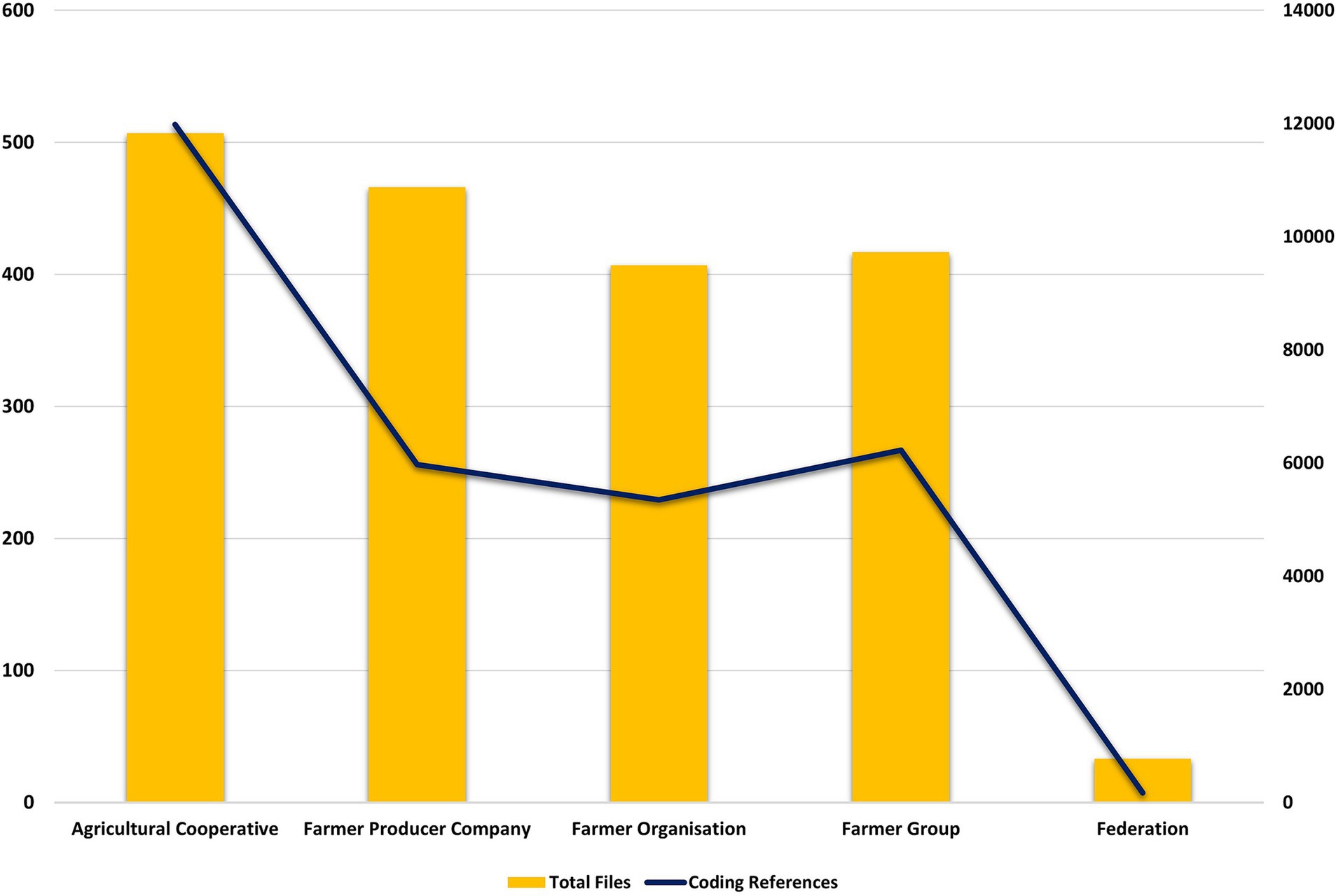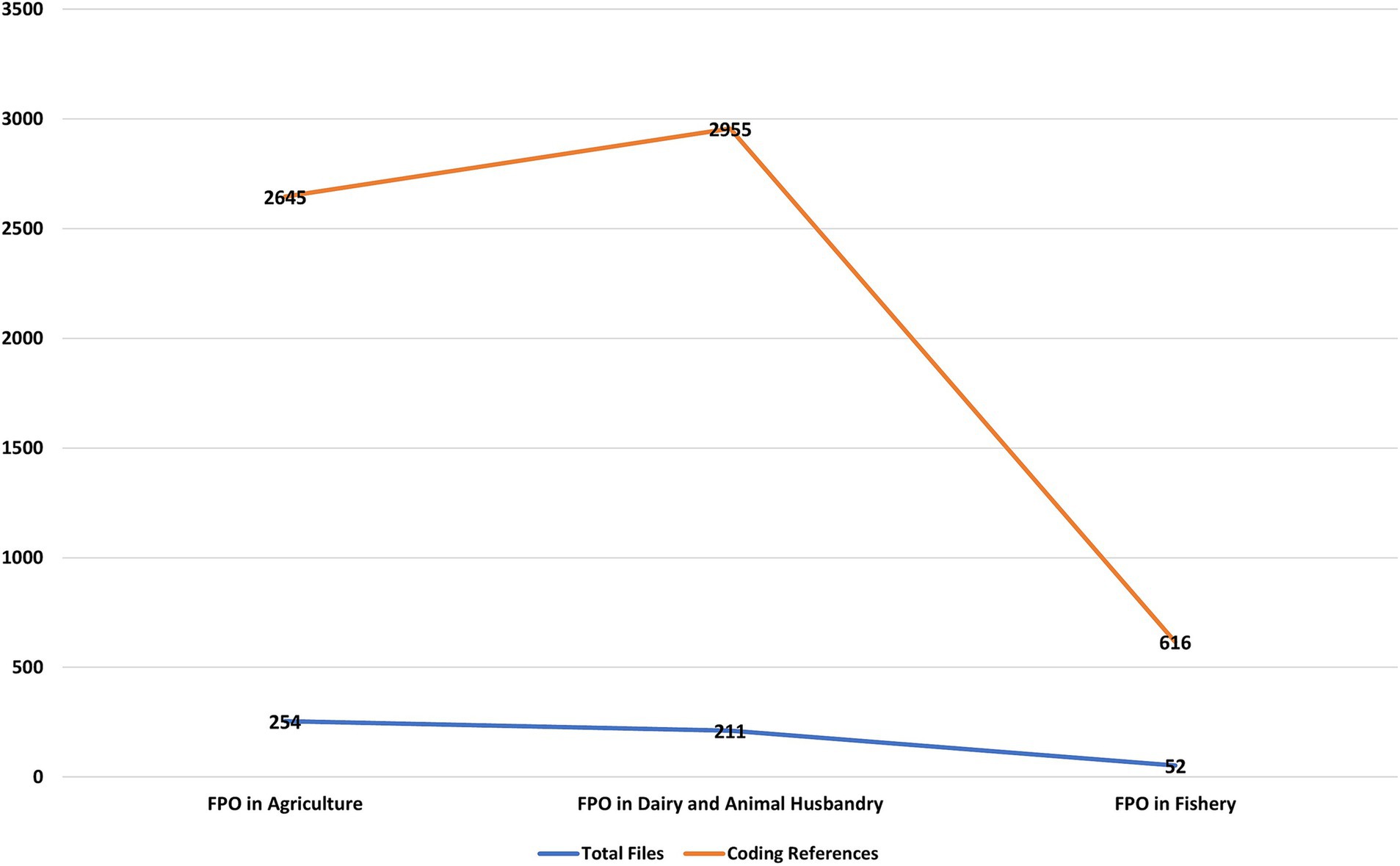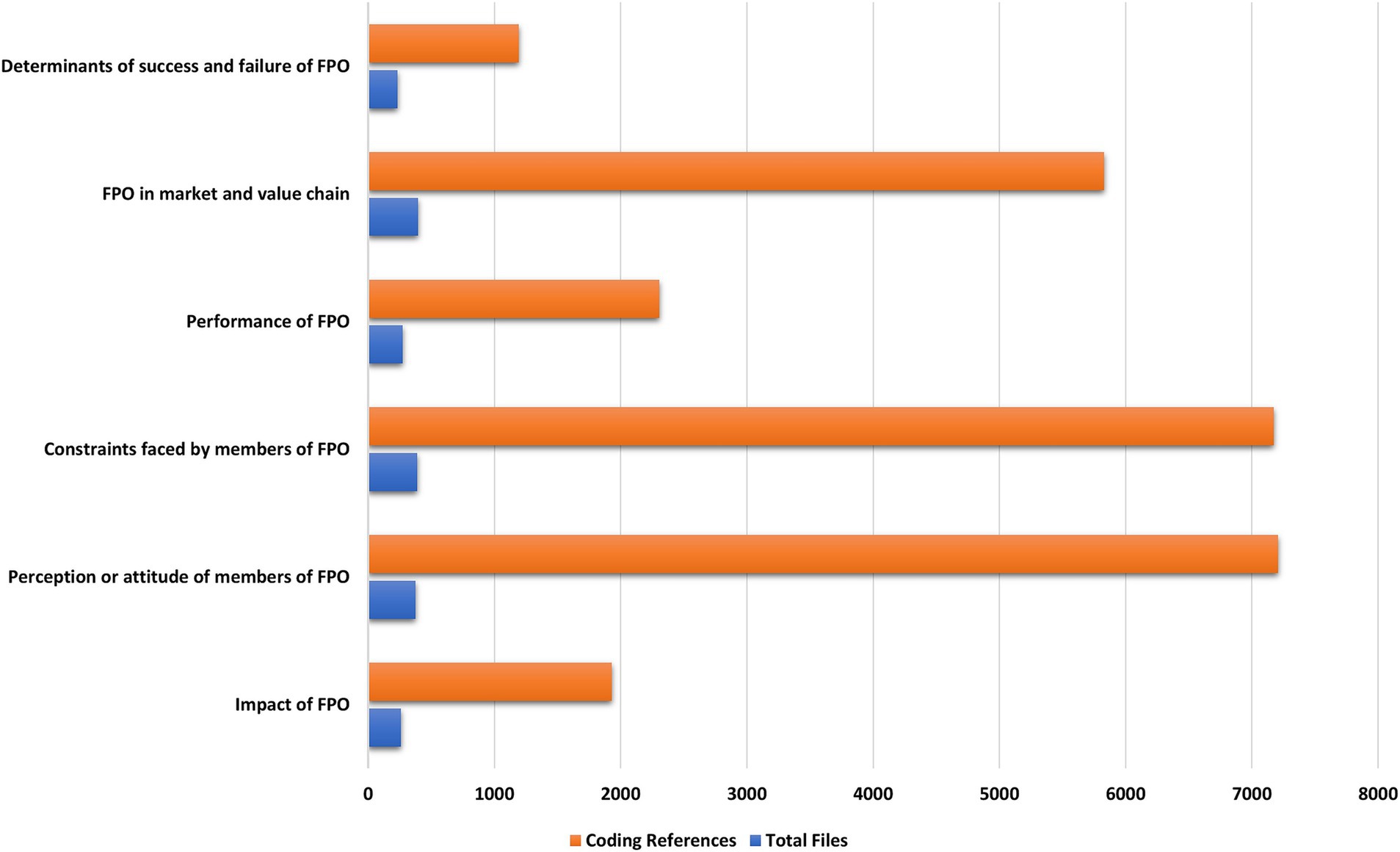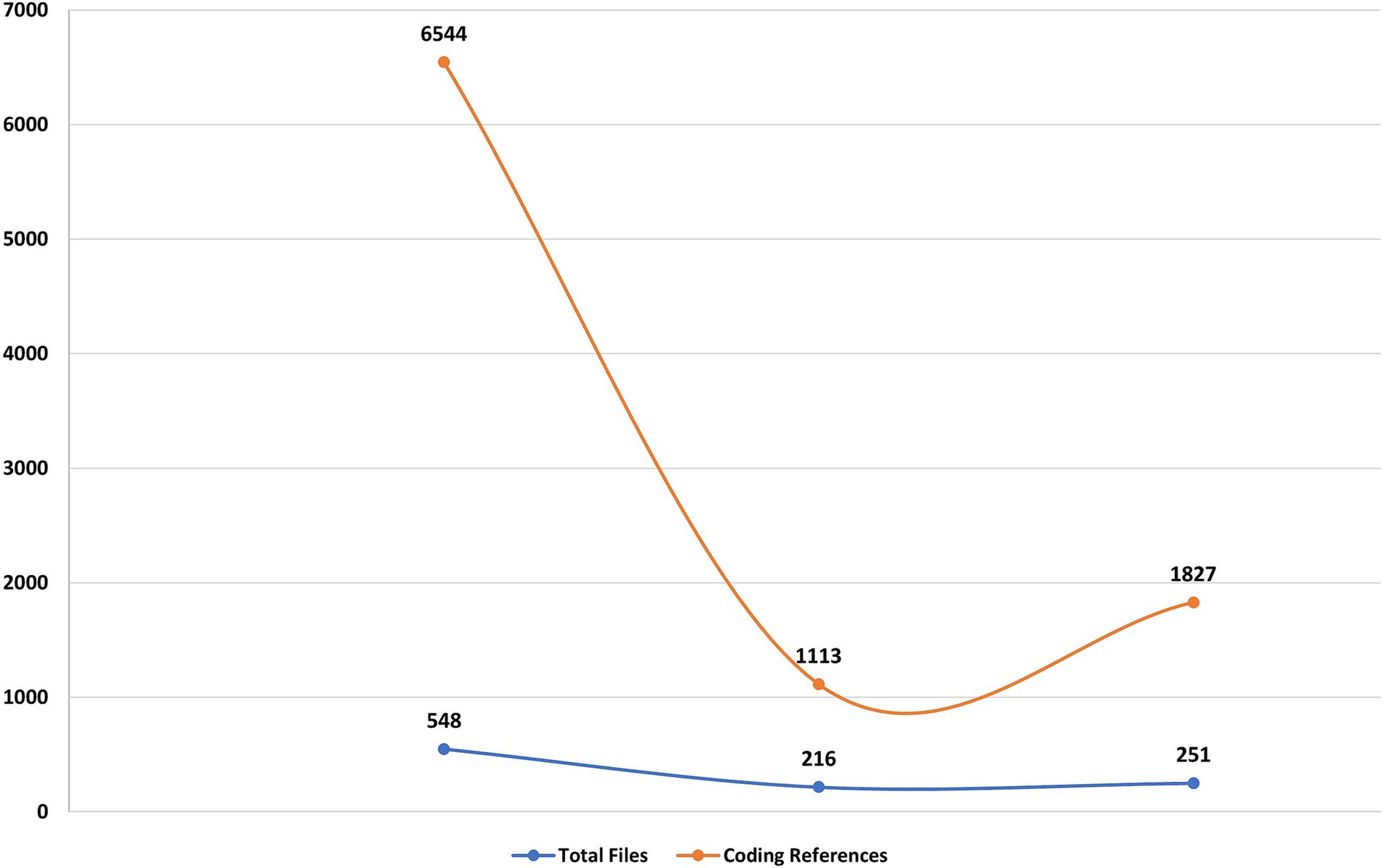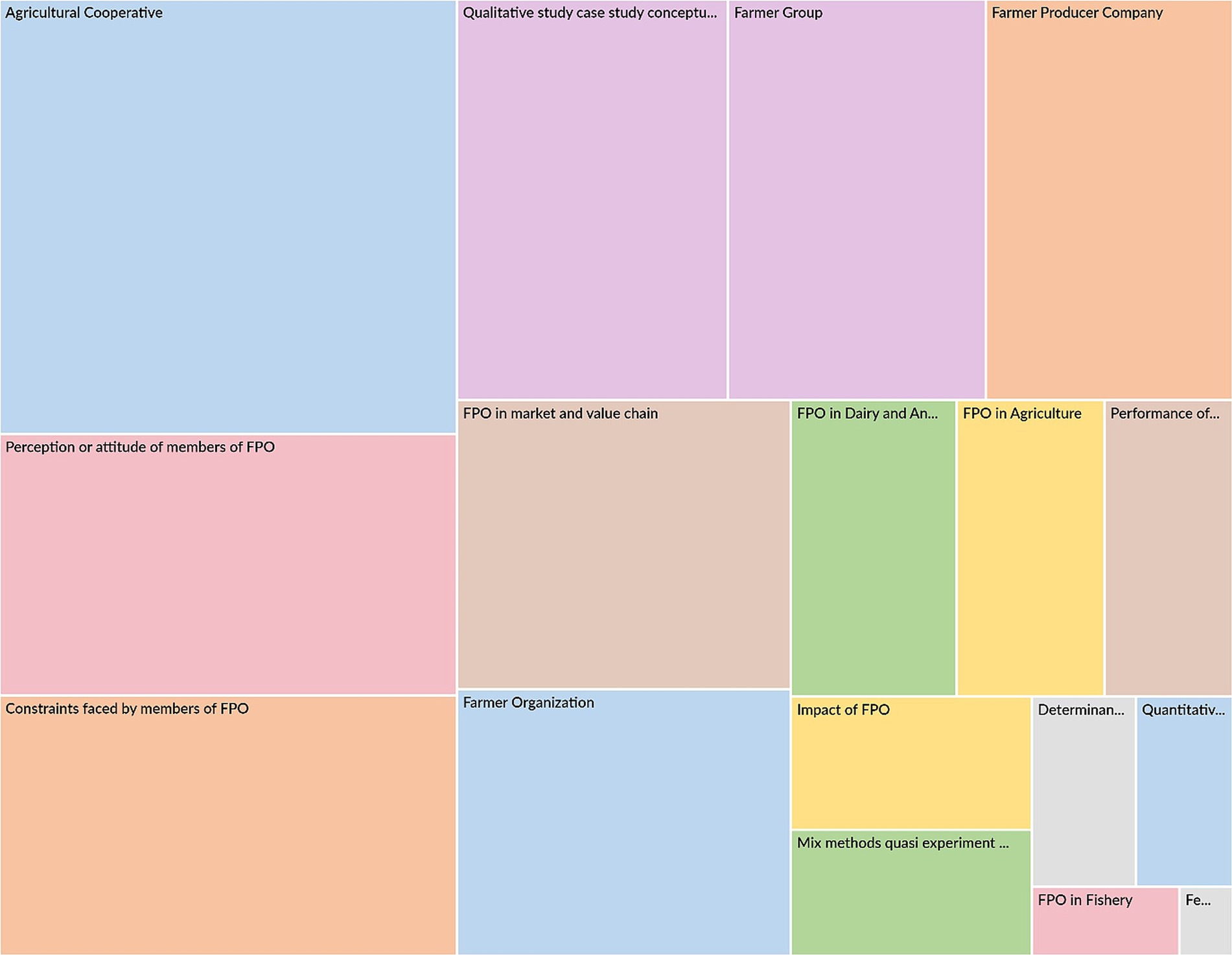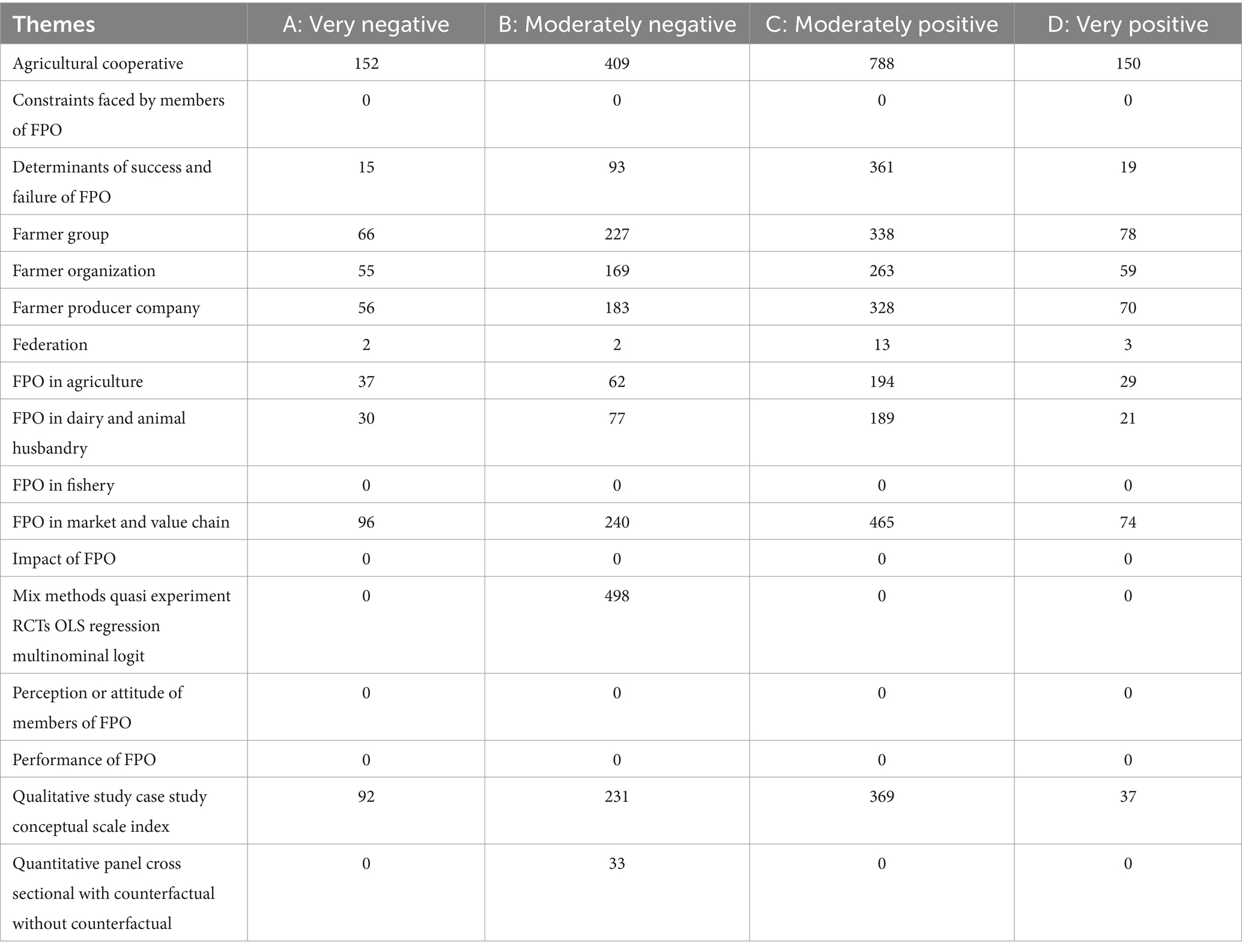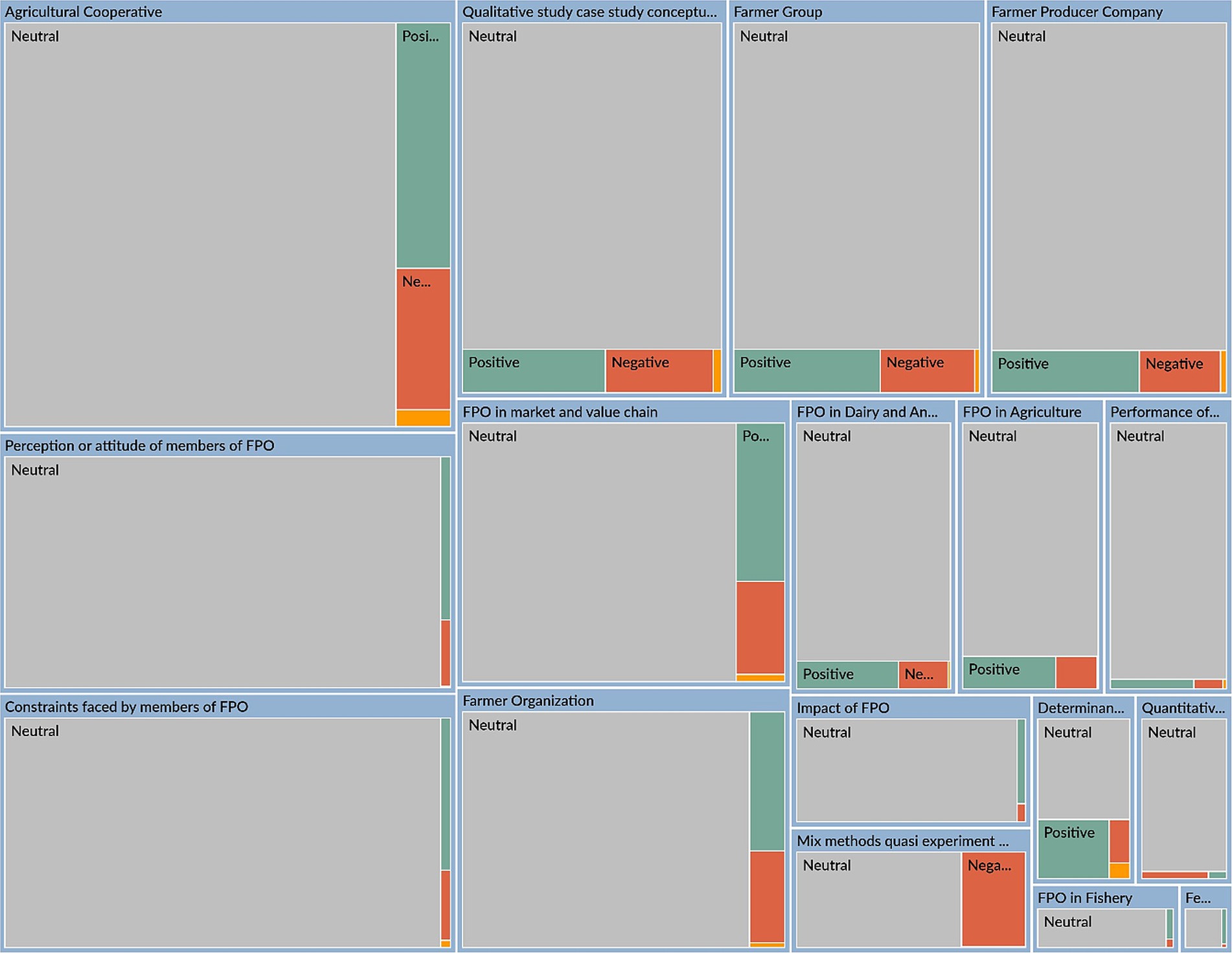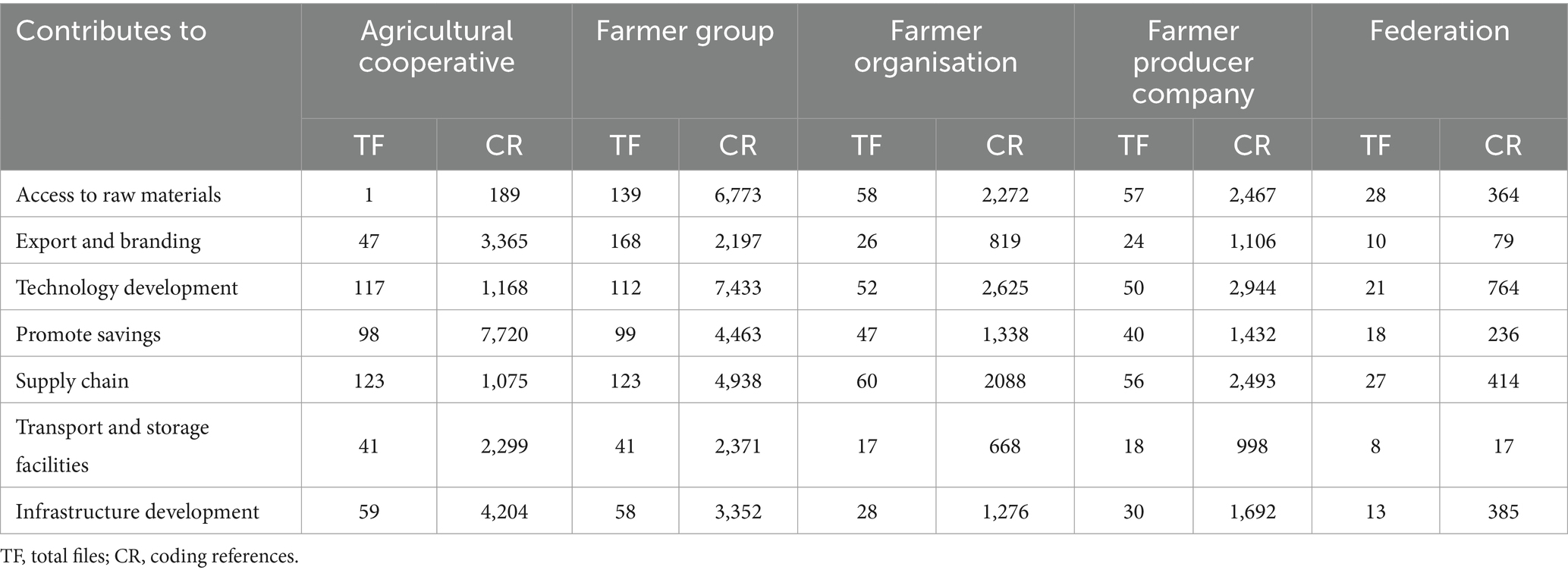- 1ICAR-Directorate of Onion and Garlic Research, Pune, India
- 2ICAR-National Institute of Agricultural Economics and Policy Research, New Delhi, India
Collective farmer models represent an important approach for smallholders to engage in agricultural activities collaboratively, fostering sustainable economic development, particularly in the context of India. The increasing frequency of published research articles on collective models highlights their significance in addressing various challenges faced by smallholder farmers in India and globally. This study is guided by three primary research questions: first, to identify trends in publications related to collective models; second, to measure the sentiments associated with the identified themes within this literature; and third, to uncover the potential of various collective models in meeting the needs of smallholder farmers, with a particular focus on India. The study analyzed research articles published from 2000 to 2024, focusing on the frequency of appearance and the content related to the functions of farm collectives. Utilizing a descriptive quantitative approach, this research employs content analysis to gather primary data from 4,382 research articles. The NVivo 15 tool is used to analyze the data, identifying key themes, functions, and support agencies as units of analysis. Through this comprehensive analysis, the study seeks to elucidate the emergence of collective models and their potential to address critical agricultural issues faced by smallholder farmers, particularly in India. The research underscores the evolving trends of farmers’ collectives, transitioning from cooperatives to contemporary Farmer Producer Companies in response to emerging needs. The findings from the global literature provide valuable insights for enhancing the development of collective models in India, where such initiatives can play a transformative role in addressing the challenges of smallholder farmers.
1 Introduction
Smallholder farmers, who constitute a significant portion of agricultural producers worldwide, have historically been disadvantaged in accessing both factor and product markets. This lack of access has impeded their ability to commercialize their produce and respond effectively to shifting market demands. As a result, they often face limited economic opportunities and low profitability. To address these challenges, various collective models have been introduced, enabling smallholders to aggregate resources, improve market access, enhance bargaining power and strengthen household welfare. Collective farming has emerged as a key approach in response to these changing demands and economic opportunities. Recent studies show that collective models such as agricultural cooperatives, farmer groups, and farmer producer organizations (FPOs) have played a crucial role in enhancing smallholder access to factor markets (such as credit, technology, and inputs) and product markets, thereby enabling commercialization and improving household welfare. It is essential to promote these organizations more widely within smallholder agricultural systems to overcome the disadvantages faced by smallholders and fostering economic development (Bijman et al., 2012).
As one of the earliest forms of farmer collectives, Agricultural cooperatives have been instrumental in reducing individualistic behavior by unifying farmers’ efforts for a common purpose (Silva et al., 2014). Cooperatives have enabled smallholder farmers to access credit, inputs, and markets collectively, which has made it possible for them to compete with larger agribusinesses (Lins and Pires, 2005; Ribeiro et al., 2012). However, cooperatives have struggled to adapt to market transformations, leading to the rise of newer collective models such as FPOs and Farmer Producer Companies (FPCs).
In India, the cooperative system faced several shortcomings, including inefficiencies and bureaucratic challenges. As a result, to overcome these issues, the Indian government introduced a new legal entity in 2002, the FPC model, under the amended Companies Act 1956. This hybrid structure of FPC model, which integrates the characteristics of private companies and cooperative societies, has shown promise in enhancing smallholder profitability by improving governance, management, and access to markets. Unlike cooperatives, FPOs and FPCs have been better equipped to handle the complexities of modern agricultural value chains (AVCs), offering smallholders a viable means to increase their income and market presence through collective action (Trebbin and Hassler, 2012). These new collective models, including FPCs and FPOs, focus on high-value horticultural crops, livestock, and cash crops, aligning with changing markets and consumer demand. The collective action theory underpins these models, which hypothesises that individuals can achieve greater long-term benefits through collaboration than by operating independently (Ostrom, 2007). Collective action within AVCs has resulted in reduced costs and higher revenues for smallholders by removing intermediaries and establishing direct marketing channels (Adhikari et al., 2017; Kumari et al., 2021a). Moreover, collective models such as FPCs are crucial in addressing broader development goals. The United Nations’ Sustainable Development Goals (SDGs), particularly those related to poverty reduction (SDG1), food security (SDG2), and sustainable agricultural practices (SDG12), directly align with the potential of collective models in agriculture (Nhemachena et al., 2018). FPCs, with their potential to serve as business hubs in rural areas, are well-positioned to contribute to the economic development of smallholder farmers while addressing broader developmental challenges (Trebbin, 2014a).
In light of these transformations in farmers’ collective models, this study aims to map the potential of various collective models using content analysis. By analyzing the taxonomy of collective models and identifying the factors responsible for their re-emergence, this research seeks to contribute to the understanding of how these models can enhance smallholder livelihoods, improve market access, and support sustainable agricultural development.
1.1 Theoretical framework
In agriculture, most farmers face significant challenges not in the production of crops, but after harvest, particularly in searching markets for their produce. Farmers within the same region often have same cropping pattern, as the sowing and harvesting periods are typically synchronized. Consequently, when the harvest reaches the market, the oversupply causes a steep decline in prices. For instance, the price of Onion can drop to as low as Rs. 2 per kg during peak harvest and surge to Rs. 200 per kg during scarcity. This price volatility is one of the major issue’s farmers encounters.
The second issue this research addresses is the quality of the produce. For farmers to secure good prices, their products must meet certain quality standards as desired by consumers and marketing agents. However, due to lack of knowledge about these standards and the high costs associated with post-harvest operations, farmers often sell their produce without grading or sorting. This results in the inclusion of uneven-sized and damaged items, which lowers the overall market value, preventing them from obtaining fair prices. The third issue explored in this paper is the lack of intellectual property (IP) registration in agriculture. Many farmers, especially smallholders, are unaware of the value of registering property rights, such as trademarks and patents. While large progressive farmers may have some knowledge in this area, the vast majority do not understand the potential benefits. Registering a trademark not only provides customer protection but also adds value to the product. Furthermore, if a farmer develops a unique farming technique, it can be patented, offering the potential to earn additional income. Small-scale farmers, when acting individually, often lack the necessary resources and scalability to address these intellectual property (IP) issues. The lack of awareness about IPs in agriculture is a critical barrier to maximizing the economic value of farming innovations. These three issues—price fluctuations, quality standards, and lack of IP registration—are closely connected to the concept of collective farming. Today, various forms of farmer collectives, such as agricultural cooperatives, farmer producer companies, farmer groups, and federations, have emerged to help farmers address these challenges. One of the solutions to price fluctuations is forming a farmers’ collective. This approach ensures quality supply by implementing sorting, grading, and storage during periods of surplus, while also facilitating distribution during times of scarcity. Developing infrastructure for value or supply chains is more manageable within FPC models, especially with government support. Membership in such collectives provides security by enhancing collective bargaining power, often through contract farming, ensuring that produce is purchased at a fixed price. This eliminates the need for farmers to constantly search for markets. Moreover, these collectives have established connections with supermarkets, which require large quantities of produce that individual smallholders cannot supply. By aggregating the produce of many smallholders, collectives can meet the bulk demands of supermarkets, thus reducing the impact of price volatility. Additionally, these farmer collectives have ability to connect to strong export networks and fulfill the quality standards requirements for international markets. Typically, high-quality produce is exported, while lower-quality goods are sold in the domestic market, where prices are generally lower. By linking smallholder farmers with collectives, farmers gain access to valuable information on quality standards, enabling them to grow their produce according to market requirements. Finally, farmer collectives can play a crucial role in promoting IP registration by raising awareness and helping farmers understand the value of securing trademarks and patents. By doing so, farmers can protect their innovations, establish brands with trademarks, Geographical Indications and enhance the value of their products. In conclusion, linking smallholder farmers to farmer collectives is an important step toward addressing the challenges of price fluctuations, quality compliance, and intellectual property awareness. Collectives not only provide economic security and access to larger markets but also equip farmers with the knowledge and tools necessary to compete in an increasingly competitive agricultural landscape (Figure 1).
1.2 Research questions
RQ1: What are the dominant themes in Farmer Collective Models?
To address this, a word frequency query was conducted, and thematic codes were developed through expert consultation. The identified themes included the types of FPOs, sectors covered, the geographical scope of the studies, and the predominant types of research (qualitative or quantitative).
RQ2: What are the key functions performed by different types of FPOs?
Major functions were identified through a matrix coding query, focusing on themes such as access to raw materials, export and branding, technology development, promotion of savings, supply chain management, transport and storage facilities, and infrastructure development. The analysis explored how different types of FPOs engage in these functions.
RQ3: Which institutions (public, private, NGO, or PPP) support the formation and functioning of FPOs?
A second matrix coding query was conducted to examine the roles of various institutional actors in supporting different types of FPOs. The query focused on the involvement of public, private, non-governmental organizations (NGOs), and public-private partnerships (PPPs) in FPO activities.
2 Methodology
A total of 4,382 articles were initially identified through the SCOPUS database. The search encompassed terms like “Farmer Producer Organization,” “Cooperative,” “Farmer Associations,” “Agricultural Cooperatives,” and related keywords, all linked with the “OR” operator to capture a broad spectrum of relevant studies. This strategy helped include a diverse set of research on FPOs and their different models, such as cooperatives and associations within the agricultural and livestock industries. Following an exclusion process based on the relevance to FPO-related research, 694 articles were selected for full-text content analysis. These articles were subsequently imported into NVivo for comprehensive analysis. Content analysis is a widely used research technique to quantify and analyze the presence of certain words, themes, or concepts within qualitative data (Eriyanto, 2011). The thematic content analysis method was applied to identify and categorize the dominant themes in the research studies.
2.1 Research tool
The qualitative data analysis software NVivo 15 was used for the coding and analysis of the selected research articles. NVivo facilitated the classification, organization, and analysis of textual data, enabling the identification of relationships between themes and codes. The analysis was carried out in various stages. The research articles were first screened for relevance, after which the full-text articles were downloaded and imported into NVivo using Zotero. This enabled seamless integration of bibliographic data and article texts into the analysis framework. The imported data were organized into codes, reflecting the identified themes. Coding stripes and highlights were applied to visually differentiate these themes. Cases were created with corresponding classifications and attributes, facilitating a structured and systematic approach to data management. Various analytical tools within NVivo were employed to explore the data. Word frequency queries and matrix coding queries were used to investigate the relationships between themes. Additionally, visual tools such as hierarchy charts, matrix charts, and word clouds were utilized to represent the data. Hierarchy charts were used to depict the structure and prominence of coding references, while word clouds highlighted the frequency of key terms within the data.
2.2 Analysis
2.2.1 Word frequency query
A word frequency query was conducted on a subset of 694 documents to identify the most commonly used terms within the selected research articles. The query was set to display the top 1,000 most frequent words, with a minimum word length of 100 characters. The grouping option was configured to narrow context, allowing for a more precise analysis of the data.
2.2.2 Matrix coding query
Matrix coding queries were employed to perform a cross-sectional analysis of various themes. The first matrix examined the relationships between five distinct types of FPOs and their respective functions. By arranging coding references according to these themes, we were able to determine which research articles emphasized specific functions. A second matrix coding query analyzed the support provided by different institutional actors (public, private, NGO, and PPP) in relation to various types of FPOs. This allowed for a comprehensive comparison of institutional involvement across different types of farmer collectives.
2.2.3 Project mapping
In NVivo, project maps were used to visually represent the relationships between different types of FPOs and their roles in various sectors. Shapes were used to represent different forms of farmer collectives, and connectors were employed to depict the relationships between these collectives and the functions they perform. Sub-functions were represented as child nodes, illustrating their position within the broader thematic categories.
Table 1 highlights the inclusion and exclusion criteria using the PICOT assignment. For clarity in the inclusion and exclusion criteria, we define smallholders, farmer collective models and Supply chain, as follow.
2.3 Smallholder
Smallholder is synonymous to “Family farming” which represents one of the most prevalent forms of farming globally, found in both developing and developed nations. This practice has a long-standing tradition in India. Most smallholder farms are family-operated and play a significant role in ensuring global food and nutritional security. There are over 500 million family farms worldwide, responsible for at least 56 percent of agricultural production on 56 percent of the land (FAO, 2014). An increasing global consensus suggests that supporting smallholder family farming could significantly reduce global hunger and poverty. Recognizing the vital contributions of family farming to food security and poverty alleviation, the United Nations declared 2014 as the ‘International Year of Family Farming’ (IYFF) (Sikka, 2014).
2.4 Farmer collective model
In this paper, we use the term collective action in the sense of farmers coming together to share their land, labour and capital and share costs and profits (Hellin et al., 2009; Soubry et al., 2020; Agarwal and Dorin, 2019). Collective action in the field of food safety remains an emerging topic within academic literature. So far, the primary focus has been on demonstrating how collective action can improve small farmers’ access to demanding markets that prioritize safety. Collective models help smallholders to integrate into the expanding global food supply chains that require greater volumes and to fetch higher prices for their products (Markelova et al., 2009). These groups are not only cost-effective but also play a crucial role in the dissemination and adoption of agricultural innovations. The establishment of farmer groups has been especially encouraged for post-harvest, marketing and processing activities, enabling them to leverage economies of scale and lower transaction costs in collective marketing, equipment acquisition, and access to training and extension services (Ochieng et al., 2018; Cao et al., 2020).
2.5 Supply chain
Supply Chain Management (SCM) involves the planning, coordination, and control of materials, parts, and finished goods from suppliers to customers. It encompasses two key processes: Production Planning and Inventory Control, as well as Distribution and Logistics (Stevens, 1989; Beamon, 1998). Production planning covers the design and management of the manufacturing process, while inventory control focuses on the management of storage and retrieval systems for raw materials and final products. Distribution and logistics ensure the efficient transport of goods from warehouses to retailers. SCM in emerging economies often exposes smallholder farmers to fraud, exploitation, corruption, and child labor, alongside environmental issues like unsustainable farming practices and financial exclusion (Bai et al., 2019; Andrew, 2013; Glavee-Geo et al., 2020; LeBaron and Gore, 2019; Protopop and Shanoyan, 2016; Schrage and Ewing, 2014; Quayson et al., 2020; McCullough et al., 2008; Nedumaran et al., 2020). Addressing these social and environmental challenges is critical to ensuring sustainability in agricultural supply chains.
3 Results and discussion
3.1 Pre-established content analysis variables
The content analysis using NVivo was conducted through word frequency and matrix coding queries on the identified themes. The themes were identified through a combination of brainstorming sessions with subject matter experts and a comprehensive review of relevant research literature. The analysis highlights the total number of files retrieved from the database and the number of coding references identified within the literature for each theme, providing a clear overview of the thematic distribution and frequency across the selected research articles.
3.2 Proportion of various collective models in the identified studies
The word frequency query on the 694 documents revealed that agricultural cooperatives were the most frequently mentioned collective model, cited in 507 files (Figure 2), likely due to their historical significance and strong government support in rural development and food security programs (Sarkar et al., 2022; Dower and Gaddis, 2021; Dendup and Aditto, 2021; Boland et al., 2021). Cooperatives have long been recognized for their ability to enhance collective bargaining (Prasertsri and Kilmer, 2008), market access (Gouët and Van Paassen, 2012; Becchetti et al., 2012), and financial services for smallholder farmers (Kamau et al., 2024; Kaleshu and Temu, 2012) leading to substantial research attention.
Following cooperatives, Farmer Producer Companies (FPCs), cited in 466 files, garnered interest due to their hybrid structure, combining cooperative benefits with a business-oriented corporate framework (Bhuyan et al., 2024; Mourya and Mehta, 2021), which has made them attractive for modern agricultural markets. The growing policy and institutional support for FPCs has further contributed to their rising prominence in research. Conversely, federations, mentioned in only 33 files, were the least studied, due to their complex organizational structure (Chance et al., 2018) and the challenges in implementation (Nain et al., 2015; Melo and Hollander, 2013), as well as fewer documented success stories compared to cooperatives and FPCs. This disparity in focus reflects the dominance of well-established models like cooperatives, the increasing relevance of FPCs, and the relative underrepresentation of federations in the literature.
3.3 Sector covered in various collective models
The analysis of 694 research articles reveals distinct trends in the development of collective models across sectors, highlighting the emerging prominence of dairy collectives and the underrepresentation of fisheries collectives in India (Figure 3). Dairy collectives, driven by financial stability in volatile market situation (Henriksen et al., 2012; Cakir and Balagtas, 2012; Blanck and Bahrs, 2011; Qian and Olsen, 2021) through initiatives like Operation Flood and the efforts of the National Dairy Development Board (NDDB), have transformed India’s fragmented dairy sector into a thriving collective model. This success is further amplified by growing market demand for dairy products (Nilsson and Ohlsson, 2007; Manfredo and Richards, 2007), social empowerment through the involvement of rural women, and advancements in technology and infrastructure. In contrast, fisheries collectives remain underdeveloped, primarily due to geographic and environmental challenges (Dawit et al., 2014; Sylvia et al., 2014; Wielgus et al., 2014), regulatory and policy gaps (Allahyari, 2010; Ünal et al., 2009), limited access to technology (Abeyrathne et al., 2014) and cold chain infrastructure, and the socio-economic marginalization of fishing communities. The seasonal nature of fishing and the isolation of these communities further hinder the establishment of sustainable collective models in this sector. As a result, while dairy collectives continue to grow and empower smallholders, fisheries collectives face significant barriers, contributing to their limited presence in the collective landscape of India.
3.4 Focused area of study of collective models
The analysis of research articles highlights significant trends in the study of collective models, with a notable focus on market and value chain dynamics, which comprises 395 files (Figure 4). This emphasis reflects the growing recognition of the importance of understanding how collective models can enhance market access (O'Brien et al., 2013; Garming et al., 2013), increase bargaining power, and improve the overall value chain for members (Mishra et al., 2024). Following closely are the constraints faced by members of collective models, represented in 390 files, indicating lack of trust, unequal work delegation, ineffective group leadership were the major constraints (Singh et al., 2023; Kumar et al., 2023) while there remains a critical need to address the challenges and limitations that hinder their effectiveness. Additionally, the perception or attitude of members toward collective models is explored in 375 files, suggesting a growing acknowledgment of the social and psychological factors influencing participation and engagement in these collectives (Hintz and Pretzsch, 2023; Cele, 2022). This multifaceted focus underscores the importance of a holistic understanding of both the opportunities and challenges associated with collective models, ultimately aiming to enhance their impact on the livelihoods of their members.
3.5 Type of research in collective models
The analysis of research articles revealed a diverse methodological landscape, with a predominance of qualitative studies, particularly case studies, which account for 548 files (Figure 5). This trend suggests that researchers prioritize in-depth, contextual insights into collective models, allowing for a nuanced understanding of their dynamics and impacts (Dey et al., 2022; Hanggana et al., 2022; Udawatta et al., 2021). Quantitative methodologies, specifically panel data studies both with and without counterfactuals total 216 files, indicating a significant interest in statistical analysis and causal inference in examining collective models.
Meanwhile, mixed methods research, including quasi-experimental designs, randomized controlled trials (RCTs), and techniques such as ordinary least squares (OLS) regression and multi-nominal logit analysis, comprises 251 files. This indicates a growing recognition of the value of integrating qualitative and quantitative approaches to provide a more comprehensive understanding of the complexities surrounding collective models. Collectively, these findings highlight the varied methodological approaches employed in the research, emphasizing the need for a multifaceted examination of collective models to effectively address their diverse impacts and challenges.
3.6 Hierarchy chart for identified themes
A hierarchy chart was used to describe the hierarchy of the code and to define the area in order to reflect the number of coding references (Figure 6). A larger area indicates more coding references. There are two types of hierarchy charts: a tree map and a sunburst.
3.7 Research literature emotional state
The sentiment analysis of 694 studies on FPOs using NVivo software reveals a diverse range of attitudes, with a stronger positive sentiment toward FPOs across various themes. The analysis identified 601 coding nodes as “very negative” and 2,224 as “moderately negative,” reflecting some concerns regarding FPOs, particularly in areas such as determinants of success and failure. However, the majority of nodes—3,308—were categorized as “moderately positive,” and 540 as “very positive,” highlighting a generally optimistic view of FPOs, especially in sectors like agriculture, dairy, and value chains.
A key finding from the sentiment analysis is the absence of sentiment coding in certain themes, such as the “constraints faced by FPO members,” “registered FPOs in the fishery sector,” “impact assessment of FPOs,” and “perceptions and performance of FPOs.” These missing elements suggest that there is a lack of research or insufficient focus on these critical areas, which could impact a comprehensive understanding of the overall challenges and benefits of FPOs. To fill these gaps, several avenues for future research are proposed. First, there is a need for additional studies focused on the perceptions of FPO members. Direct engagement with FPO members through qualitative surveys or interviews could offer valuable insights into their attitudes, expectations, and challenges, which are essential for understanding the internal dynamics and effectiveness of FPOs (Zhao and Strotmann, 2015). Second, although some research has examined the impact of FPOs, more in-depth and longitudinal studies are needed to evaluate the long-term socio-economic outcomes of FPO participation (Low and Siegel, 2020). Future research should consider mixed methods to explore not only the economic impacts but also the social, educational, and cultural consequences. Another area that needs further exploration is the role of FPOs in the fishery sector, which has received limited sentiment analysis. Given the unique challenges faced by the fishery and aquaculture sectors, such as market access, resource management, and sustainability, future studies should investigate the role of FPOs in these sectors (Kumar and Sharma, 2021). Lastly, the analysis highlighted gaps in understanding the constraints that FPOs face, particularly in relation to their performance. Research aimed at identifying and addressing barriers such as limited access to finance, inadequate infrastructure, and policy-related issues would be essential to support the growth and success of FPOs (Singh and Yadav, 2023). These recommendations identify critical research areas that could deepen the understanding of FPOs’ potential and challenges, ultimately contributing to their development and to agricultural growth. Despite these challenges, the overall sentiment remains positive, indicating confidence in the role of FPOs in agricultural development and market integration (Table 2; Figure 7).
3.8 Potential domains and role of different collective models
Across the studies, cooperatives remain the dominant collective model, particularly in countries like India, Mexico, Kenya, and South Africa. While cooperatives continue to play a significant role, newer collective models have also emerged, often based on the same cooperative principles of voluntary membership, member control, and autonomy. However, these newer models differ in their governance structures, member rights, and market orientations. These diverse collective models offer solutions to specific challenges faced by producers, particularly in terms of access to factor and product markets. Moving beyond a one-size-fits-all approach, embracing varied collective arrangements could be key to increasing smallholder participation and enhancing the viability of collective models in different contexts (Table 3).
3.8.1 Agricultural cooperatives: savings, infrastructure development, and export and branding
Agricultural cooperatives have a long-standing history in rural development, evolving as a key institutional framework to support smallholder farmers in addressing their financial and market challenges. The genesis of cooperatives in India can be traced back to the Cooperative Societies Act of 1904, introduced by the British government based on the Raiffersen model of German agricultural credit cooperatives (Kumar, 2003). However, cooperatives in India have even earlier roots, with the establishment of the first cooperative society in Baroda, Gujarat, in 1889, known as Anyona Sahayak Sahakari Mandali Limited, based on the recommendations of Sir Fredrick Nicholson. Initially, cooperatives were created to provide farmers with access to credit, aimed at rescuing them from exploitative moneylenders and poverty (Pramod, 2010). Over time, cooperatives expanded their scope to include other functions such as marketing, processing, housing, and the purchasing of consumer goods. The importance of agricultural cooperatives lies in their ability to promote savings, infrastructure development, and access to credit for small and marginal farmers. By pooling resources, cooperatives enable farmers to invest in essential inputs, such as seeds, fertilizers, and machinery, thereby improving agricultural productivity. Kehinde and Ogundeji (2022) found that farmers who have simultaneous access to credit and cooperative services achieve significantly higher productivity than those without. This highlights the role of cooperatives in enhancing farm size, productivity, and overall economic stability. Furthermore, cooperatives provide farmers with a platform to engage in collective marketing, allowing them to access better markets, negotiate favorable terms, and reduce transaction costs, thereby improving their bargaining power.
Despite these benefits, agricultural cooperatives face several challenges. Low commercialization potential stemmed from the fact that the cooperatives were not able to adequately respond to changing markets and changing consumer demand, leading to the emergence of newer farmer aggregation models or significant overhaul of existing cooperative laws beginning in the early 1990s (Kariuki and Loy, 2016; Latynskiy and Berger, 2017; Markelova and Mwangi, 2010; Meador et al., 2016; Trebbin, 2014b). One of the major obstacles to cooperative development is the tendency of farmers to prioritize short-term gains over long-term investments. Chayanov’s theory explains that farmers face social and economic pressures that necessitate a constant cash flow, making them less inclined to join cooperatives unless they see an immediate material advantage (Hu et al., 2023). Furthermore, cooperatives often lack effective leadership and management, which diminishes member engagement, particularly in marketing cooperatives where farmers rely heavily on the cooperative’s performance for their income (Awoke, 2021). Additionally, input-supplying cooperatives require minimal member involvement, leading to a disconnect between farmers and cooperative decision-making processes, reducing the sense of ownership and commitment (Bhanot et al., 2021). The shift from cooperatives to Producer Organizations (POs) and Farmer Producer Companies (FPCs) is rooted in the limitations of the cooperative model.
While cooperatives were initially established to provide farmers with credit and market access, their scope and impact have diminished due to structural inefficiencies and declining member participation. POs and FPCs, on the other hand, offer a more flexible and entrepreneurial approach to collective action. Unlike traditional cooperatives, FPCs are designed to operate as business enterprises, offering farmers greater control over decision-making, market access, and the adoption of new technologies. This shift reflects the need for a more dynamic and market-oriented model that can better address the diverse needs of farmers in the modern agricultural landscape (Kakati and Kakoty, 2022).
3.8.2 Farmer groups and farmer organizations: technology development, access to raw materials, and supply chains
Farmer Interest Groups (FIGs) emerged as informal collectives of small-scale farmers, typically comprising 25–35 members, primarily focused on subsistence farming (Dolinska and d’Aquino, 2016). These groups were created to help farmers access agricultural inputs such as seeds, fertilizers, water and to foster the sharing of knowledge and skills related to modern farming techniques. By coming together in FIGs, smallholder farmers were able to pool their resources and gain better access to raw materials that would have been difficult to acquire individually. This grassroots-level organization was crucial in promoting technology adoption at the village level, allowing farmers to implement better cultivation practices, leading to improved yields and productivity (Ingutia and Sumelius, 2022). FIGs played an essential role in empowering small farmers by promoting collective action. However, their informal nature and small size limited their ability to influence larger market structures, improve bargaining power, or significantly contribute to agricultural modernization beyond the local context. Despite their benefits in technology dissemination and resource sharing, FIGs faced challenges in scaling operations and accessing broader markets. These limitations highlighted the need for a more formal structure to support farmers in a competitive and growing global supply chain.
As FIGs demonstrated their value at the grassroots level but also revealed limitations in terms of market access, bargaining power, and economic scale, there arose a need for a more structured organization. This need led to the evolution of Farmer Producer Organizations (FPOs), which typically consist of 300 or more members, often formed by bringing together 15–20 FIGs (Nikam et al., 2019). FPOs provided a more formalized structure, offering farmers the ability to aggregate their produce, access credit, and negotiate better terms in markets. FPOs were established to address these issues, enabling small farmers to benefit from collective strength while still retaining some of the grassroots-level advantages of FIGs. FPOs focus on supply chain development, market linkages, and providing farmers access to better resources and technologies. By facilitating access to larger markets and reducing input costs, FPOs play a vital role in improving farmer incomes and promoting agricultural sustainability (Nikam et al., 2019).
The shift from FIGs to FPOs demonstrates the evolving needs of smallholder farmers and the increasing importance of formal organizations in addressing these needs. As FPOs continue to grow, they serve as a bridge between the traditional, informal farmer collectives and the more structured agricultural cooperatives that dominate large-scale commercialized farming.
3.8.3 Farmer producer companies: technology development, supply chains, and access to raw materials
In the evolving landscape of agricultural institutional innovations, Farmer Producer Companies (FPCs) have emerged as a significant collective model, providing both forward and backward linkages to small and marginal farmers. As a collective institution, FPCs enhance farmers’ bargaining power by facilitating access to markets, timely credit, and technical knowledge, helping farmers overcome the limitations of traditional agricultural cooperatives and Farmer Producer Organizations (FPOs) (Bernard and Spielman, 2009; Hellin et al., 2009; Trebbin and Hassler, 2012; Trebbin, 2014a). The ability of FPCs to address the constraints that have historically hampered cooperatives and FPOs, including inefficiencies in vertical coordination and limited market access, represents a vital shift in the agricultural sector. Central to understanding the effectiveness of FPCs is the application of Prospect Theory in farmers’ decision-making processes. Farmers often use an internal reference price to evaluate the desirability of selling through various marketing channels, such as Agricultural Produce Market Committees (APMCs), contract farming (CF), or FPCs. The deviations from this reference price heavily influence farmers’ choices, with losses being perceived more acutely than equivalent gains. This loss aversion tendency suggests that farmers derive greater utility when choosing alternative marketing channels that provide better safeguards against loss, especially in uncertain market conditions (Otsuka et al., 2016; Markelova et al., 2009; Winters et al., 2005). FPCs, by reducing cultivation costs and providing market linkages, offer a pathway to mitigate potential losses even when price assurances are not guaranteed. The multiple benefits provided by FPCs—access to timely credit, market information, good cultivation practices, economies of scale, and access to high-value markets—support farmers in multiple ways (Otsuka et al., 2016; Markelova et al., 2009). FPCs also serve as a conduit for technology transfer, introducing farmers to improved agricultural practices that reduce input costs, which is particularly valuable for small and marginal farmers who struggle to compete in traditional markets. While FPC membership does not guarantee price stability, the reduction in cultivation costs helps shield farmers from distress sales by offering an indirect safety net.
Another pivotal role of FPCs is in reducing transportation costs. In cases where designated collection centers are established, farmers can save on transportation expenses, which are often prohibitive for small farmers. When collection centers are absent, farmers bear the transport costs themselves, but the FPC deducts input costs from the final payment, ensuring that farmers only pay for what they have used (Mourya and Mehta, 2021). This arrangement simplifies the process for farmers, allowing them to focus on production rather than the complexities of logistics. Despite the advantages offered by FPCs, it is essential to acknowledge the operational heterogeneity across different FPCs and CF models. Some FPCs are highly successful due to their homogeneity and streamlined operations, while others are less effective due to varying activities and weaker vertical coordination. This heterogeneity also extends to contracting firms, which differ based on their terms of engagement, level of vertical coordination, and inclusion of small farmers. The variability in performance across FPCs and CFs underlines the need for further research into how these models can be optimized to serve farmers better across different regions and contexts (Kumari et al., 2021b).
4 Conclusion
This study utilizes NVivo 15 for a comprehensive text analysis of 694 documents, employing mind maps, word frequency analysis, and matrix coding to explore the potential of farmer collective models. The focus of the analysis is on qualitative, emotional, and thematic content, providing valuable insights into the evolving nature of collective models. The distribution of research articles across different collective models, such as cooperatives, Farmer Producer Organizations (FPOs), and farmers’ groups, has shifted over time, with newer models gaining more attention in recent years. Although agricultural cooperatives have contributed significantly to promoting savings and infrastructure development for smallholder farmers, their declining effectiveness and inability to adapt to the changing market dynamics have created space for the emergence of Producer Organizations (POs) and Farmer Producer Companies (FPCs). These newer institutions offer a more sustainable, farmer-centered approach to addressing the challenges smallholder farmers face, particularly in accessing credit, markets, and technology. FPCs represent a notable innovation, providing a range of support services that reduce farmers’ dependence on exploitative traditional market mechanisms and enhance their resilience to market fluctuations. By addressing the limitations of earlier cooperative models, FPCs help facilitate the adoption of new technologies and market linkages, positioning them as key drivers of agricultural transformation in India. However, the varying performance of FPCs indicates that there is a need for refinement in these models to fully maximize their benefits for all farmers. While collective models have shown considerable promise, there remain gaps in understanding their long-term organizational performance, particularly regarding sustainability and scalability. One important limitation in the current study is the gaps in sentiment coding, which may impact the interpretation of the data. Additionally, institutional heterogeneity across different models may affect the generalizability of the findings. Future research should aim to evaluate the performance of these collective models across diverse contexts and sectors, considering these limitations, to provide a more comprehensive understanding of their potential and long-term viability.
Data availability statement
The original contributions presented in the study are included in the article/supplementary material, further inquiries can be directed to the corresponding author.
Author contributions
RK: Conceptualization, Funding acquisition, Methodology, Project administration, Resources, Supervision, Writing – review & editing. PD: Data curation, Formal analysis, Investigation, Methodology, Software, Visualization, Writing – original draft, Writing – review & editing. VN: Data curation, Investigation, Supervision, Validation, Writing – review & editing. KK: Data curation, Formal analysis, Investigation, Visualization, Writing – original draft, Writing – review & editing. SG: Project administration, Resources, Writing – review & editing. VM: Resources, Supervision, Writing – review & editing.
Funding
The author(s) declare that financial support was received for the research, authorship, and/or publication of this article. APC for this article was paid by Directorate of Onion and Garlic Research, Pune.
Conflict of interest
The authors declare that the research was conducted in the absence of any commercial or financial relationships that could be construed as a potential conflict of interest.
Generative AI statement
The authors declare that no Generative AI was used in the creation of this manuscript.
Publisher’s note
All claims expressed in this article are solely those of the authors and do not necessarily represent those of their affiliated organizations, or those of the publisher, the editors and the reviewers. Any product that may be evaluated in this article, or claim that may be made by its manufacturer, is not guaranteed or endorsed by the publisher.
References
Abeyrathne, H. R. M. P., Chandana, J., and Liyanarachchi, N. (2014). Impact of group interactions on farmers' entrepreneurial behaviour. E+ M Ekonomie a Manag. 17, 46–57. doi: 10.15240/tul/001/2014-4-004
Adhikari, S., Williams, F., and Collins, R. (2017). Impact of agricultural value chains on smallholder livelihoods: a systematic review. World Dev. 95, 132–143.
Agarwal, B., and Dorin, B. (2019). Group farming in France: why do some regions have more cooperative ventures than others? Environ. Plan. A 51, 781–804. doi: 10.1177/0308518X18802311
Allahyari, M. S. (2010). Social sustainability assessment of fishery cooperatives in Guilan Province, Iran. J. Fish. Aquatic Sci. 5, 216–222.
Andrew, C. (2013). Modern slavery as a management practice: exploring the conditions and capabilities for human exploitation. Acad. Manag. Rev. 38, 45–69. doi: 10.2307/23416302
Awoke, M. U. (2021). The challenges of cooperative societies: relevance and sustainability in the modern agricultural sector. J. Coop. Stud. 47, 101–114.
Bai, C., Shi, B., Liu, F., and Sarkis, J. (2019). Banking credit worthiness: evaluating the complex relationships. Omega 83, 26–38. doi: 10.1016/j.omega.2018.02.001
Beamon, B. M. (1998). Supply chain design and analysis: models and methods. Int. J. Prod. Econ. 55, 281–294. doi: 10.1016/S0925-5273(98)00079-6
Becchetti, L., Conzo, P., and Gianfreda, G. (2012). Market access, organic farming and productivity: the effects of fair trade affiliation on Thai farmer producer groups. Aust. J. Agric. Resour. Econ. 56, 117–140. doi: 10.1111/j.1467-8489.2011.00574.x
Bernard, T., and Spielman, D. J. (2009). Reaching the rural poor through rural producer organizations? A study of agricultural marketing cooperatives in Ethiopia. Food Policy 34, 60–69. doi: 10.1016/j.foodpol.2008.08.001
Bhanot, R., Mishra, P., and Agarwal, S. (2021). Agricultural cooperatives and member participation: challenges and future directions. Int. J. Rural Dev. 12, 56–72.
Bhuyan, R., Das, B., and Khound, S. (2024). Understanding farmer producer company (FPC) ecosystem in Assam: issues and challenges. J. Asian Afr. Stud. 59, 692–703. doi: 10.1177/00219096221120921
Bijman, J., Iliopoulos, C., Poppe, K. J., Gijselinckx, C., Hagendorn, K., and Hanisch, M. (2012). Support for Farmers’ Cooperatives. European commission’s technical report. The Netherlands: Wageningen University, Wageningen, 1–127.
Blanck, N., and Bahrs, E. (2011). The financial stability of dairy cooperatives in volatile markets. Journal of the Austrian Society of Agricultural Economics 20, 97–106.
Boland, M. A., Briggeman, B. C., Jacobs, K., Kenkel, P., McKee, G., and Park, J. L. (2021). Research priorities for agricultural cooperatives and their farmer-members. Appl. Econ. Perspect. Policy 43, 573–585. doi: 10.1002/aepp.13068
Cakir, M., and Balagtas, J. V. (2012). Estimating market power of US dairy cooperatives in the fluid milk market. Am. J. Agric. Econ. 94, 647–658. doi: 10.1093/ajae/aar136
Cao, Y., Zhang, X., and He, L. (2020). Collective action in maintaining rural infrastructures: cadre-farmer relationship, institution rules and their interaction terms. Land Use Policy 99:105043. doi: 10.1016/j.landusepol.2020.105043
Cele, L. (2022). Youth perceptions of, and willingness to join Irish dairy cooperatives and their governance. J. Co-op. Org. Manag. 10:100180. doi: 10.1016/j.jcom.2022.100180
Chance, Q., Le Velly, R., and Goulet, F. (2018). How to influence the trajectory of organic agriculture’s development when you are not in the driver’s seat? The case of the French National Federation of organic farming. Open Agricult. 3, 632–643. doi: 10.1515/opag-2018-0066
Dawit, G., Asefa, A., Gezahegn, A., and Fekadu, F. (2014). Analysis of the impact of fishery cooperatives on fishing activity of rural households around Lake Ziway and Lagano in Ethiopia. Middle-East Journal of Scientific Research. Middle-East Journal of Scientific Research 19, 144–162. doi: 10.5829/idosi.mejsr.2014.19.2.11740
Dendup, T., and Aditto, S. (2021). Determinants of households’ membership in agricultural cooperatives in Bhutan. Journal of Agriculture and Rural Development in the Tropics and Subtropics, 122 173–181. doi: 10.17170/kobra-202107134321
Dey, B., Visser, B., Tin, H. Q., Mahamadou Laouali, A., Baba Toure Mahamadou, N., Nkhoma, C., et al. (2022). Strengths and weaknesses of organized crop seed production by smallholder farmers: a five-country case study. Outlook Agricult. 51, 359–371. doi: 10.1177/00307270221115454
Dolinska, A., and d’Aquino, P. (2016). Farmers as agents in innovation systems. Empowering farmers for innovation through communities of practice. Agricultural systems 142, 122–130.
Dower, B., and Gaddis, J. (2021). Relative to the landscape: producer cooperatives in native food sovereignty initiatives. J. Co-oper. Organiz. Manag. 9:100147. doi: 10.1016/j.jcom.2021.100147
Eriyanto (2011). Analisis isi: Pengantar metodologi untuk penelitian ilmu komunikasi dan ilmu-ilmu sosial lainnya : Kencana Prenada Media Group, Perpustakaan UI, Lantai 2.
Garming, H., Castellon, N., Rajala, S., Grote, U., and Staver, C. (2013). Banana value chains in Central America-options for smallholders on domestic and regional markets. Acta Hortic. 986, 331–338. doi: 10.17660/ActaHortic.2013.986.35
Glavee-Geo, R., Burki, U., and Buvik, A. (2020). Building trustworthy relationships with smallholder (small-scale) agro-commodity suppliers: insights from the Ghana cocoa industry. J. Macromark. 40, 110–127. doi: 10.1177/0276146719900370
Gouët, C., and Van Paassen, A. (2012). Smallholder marketing cooperatives and smallholders’ market access: lessons learned from the actors involved. J. Agric. Educ. Ext. 18, 369–385. doi: 10.1080/1389224X.2012.691784
Hanggana, S., Suwarto, S., Bandi, B., and Anantanyu, S. (2022). Characteristics of effectively farmer groups to manage agricultural machinery rental business: a multi-case study approach. Qual. Rep. 27, 1133–1154. doi: 10.46743/2160-3715/2022.5255
Hellin, J., Lundy, M., and Meijer, M. (2009). Farmer organization, collective action and market access in Meso-America. Food Policy 34, 16–22. doi: 10.1016/j.foodpol.2008.10.003
Henriksen, I., Hviid, M., and Sharp, P. (2012). Law and peace: contracts and the success of the Danish dairy cooperatives. J. Econ. Hist. 72, 197–224. doi: 10.1017/S0022050711002488
Hintz, K. S., and Pretzsch, J. (2023). Smallholder perceptions of and willingness to participate in Forest Farmers' organizations: insights from case studies in Ethiopia and Tanzania. Forest Policy Econ. 149:102929. doi: 10.1016/j.forpol.2023.102929
Hu, X., Sun, Y., and Liu, Y. (2023). Farmers' decision-making in cooperative membership: insights from prospect theory. Agric. Econ. Rev. 34, 115–131.
Ingutia, M., and Sumelius, J. (2022). Farmer groups and cooperatives: pathways to agricultural development. J. Agricult. Dev. 25, 135–156.
Kakati, A., and Kakoty, S. (2022). From cooperatives to farmer producer companies: the transition and its implications for agricultural development. Ind. J. Rural Stud. 84, 200–213.
Kaleshu, J. T., and Temu, S. (2012). Expansion of rural financial services through linkage banking in Tanzania: is joint action between savings and credit cooperative societies (SACCOS) a promising approach? Enterprise Dev. Microfin. J. 23, 146–160. doi: 10.3362/1755-1986.2012.015
Kamau, J. N., Mathuva, D. M., and Ndiritu, S. W. (2024). Digital transformation: a study of how SACCO members in Kenya experience financial inclusion through digital financial services. Forum Scientiae Oeconomia 12, 139–150. doi: 10.23762/FSO_VOL12_NO1_7
Kariuki, I. M., and Loy, J. P. (2016). Contractual farming arrangements, quality control, incentives, and distribution failure in Kenya's smallholder horticulture: a multivariate probit analysis. Agribusiness 32, 547–562. doi: 10.1002/agr.21462
Kehinde, T. O., and Ogundeji, A. (2022). Impact of cooperative membership and access to credit on farm productivity: evidence from smallholder farmers. J. Agric. Econ. 73, 415–432.
Kumar, S. M. (2003). The evolution of cooperative societies in India: historical perspectives. J. Ind. Cooper. Stud. 22, 45–52.
Kumar, S., Kumar, R., Meena, P. C., and Kumar, A. (2023). Determinants of performance and constraints faced by farmer producer organizations (FPOs) in India. Ind. J. Extension Educ. 59, 1–5. doi: 10.48165/IJEE.2023.59201
Kumar, A., and Sharma, V. (2021). The role of FPOs in fisheries and aquaculture: challenges and opportunities. J. Aquatic Stud. 35, 123–137.
Kumari, S., Bharti, N., and Tripathy, K. K. (2021a). Strengthening agriculture value chain through collectives: comparative case analysis. Int. J. Rural. Manag. 17, 40S–68S. doi: 10.1177/0973005221991438
Kumari, M., Lal, R., and Singh, B. (2021b). Agricultural value chain and cooperatives: a pathway for sustainable development. J. Agribusi. Develop. Emerg. Econom. 11, 402–419.
Latynskiy, E., and Berger, T. (2017). Assessing the income effects of group certification for smallholder coffee farmers: agent-based simulation in Uganda. J. Agricult. Econom. 68, 727–748. doi: 10.1111/1477-9552.12212
LeBaron, G., and Gore, E. (2019). Gender and forced labour: understanding the links in global cocoa supply chains. J. Develop. Stud. 56, 1095–1117. doi: 10.1080/00220388.2019.1657570
Lins, J., and Pires, J. (2005). Cooperativism and its role in family farming: a comparative analysis. J. Agrar. Stud. 22, 37–52.
Low, P., and Siegel, M. (2020). Assessing the socio-economic impact of FPO participation: a longitudinal approach. J. Rural. Dev. 58, 245–267.
Manfredo, M. R., and Richards, T. J. (2007). Cooperative risk management, rationale, and effectiveness: the case of dairy cooperatives. Agricult. Fin. Rev. 67, 311–339. doi: 10.1108/00214660780001211
Markelova, H., Meinzen-Dick, R., Hellin, J., and Dohrn, S. (2009). Collective action for smallholder market access. Food Policy 34, 1–7. doi: 10.1016/j.foodpol.2008.10.001
Markelova, H., and Mwangi, E. (2010). Collective action for smallholder market access: evidence and implications for Africa. Rev. Policy Res. 27, 621–640. doi: 10.1111/j.1541-1338.2010.00462.x
McCullough, E. B., Pingali, P. L., and Stamoulis, K. G. (2008). The transformation of Agri-food systems: globalization, supply chains and smallholder farmers. FAO, 1–370.
Meador, J. E., O’Brien, D. J., Cook, M. L., Grothe, G., Werner, L. A., Diang’a, D., et al. (2016). Building sustainable smallholder cooperatives in emerging market economies: findings from a five-years project in Kenya. Sustainability 8:656. doi: 10.3390/su8070656
Melo, C. J., and Hollander, G. M. (2013). Unsustainable development: alternative food networks and the Ecuadorian Federation of Cocoa Producers, 1995–2010. J. Rural. Stud. 32, 251–263. doi: 10.1016/j.jrurstud.2013.07.004
Mishra, V., Ishdorj, A., Tabares Villarreal, E., and Norton, R. (2024). Collaboration in agricultural value chains: a scoping review of the evidence from developing countries. J. Agribusi. Develop. Emerg. Econom. doi: 10.1108/JADEE-12-2023-0311
Mourya, M., and Mehta, M. (2021). Farmer producer company: India’s magic bullet to realise select SDGs? Int. J. Rural. Manag. 17, 115S–147S. doi: 10.1177/0973005221991660
Nain, M. S., Singh, R., Kumar, S., and Chahal, V. P. (2015). Farmers’ producer organisation in reducing transactional costs: a study of Tamil Nadu mango growers federation (TAMAFED). Indian J. Agric. Sci. 85, 1303–1307. doi: 10.56093/ijas.v85i10.52269
Nedumaran, S., Selvaraj, A., Nandi, R., Suchiradipta, B., Jyosthnaa, P., and Bose, D. (2020). Digital integration to enhance market efficiency and inclusion of smallholder farmers: a proposed model for fresh fruit and vegetable supply chain. Int. Food Agribusi. Manag. Rev. 23, 319–337.
Nhemachena, C., Nhemachena, C., and Hassan, R. (2018). Sustainable development goals and agriculture: a review of Progress and priorities. Agric. Econ. Res. Rev. 21, 11–23.
Nikam, V., Singh, P., Ashok, A., and Kumar, S. (2019). Farmer producer organisations: Innovative institutions for upliftment of small farmers. The Indian Journal of Agricultural Sciences, 89, 1383–1392.
Nilsson, J., and Ohlsson, C. (2007). The New Zealand dairy cooperatives’ adaptation to changing market conditions. J. Rural Coop. 35, 43–70.
O'Brien, D. J., Banwart, L., and Cook, M. L. (2013). Measuring the benefits of smallholder farmer membership in producer-controlled vertical value chains: survey findings from a development project in East Africa. Poverty Public Policy 5, 399–416. doi: 10.1002/pop4.50
Ochieng, J., Knerr, B., Owuor, G., and Ouma, E. (2018). Strengthening collective action to improve marketing performance: evidence from farmer groups in Central Africa. J. Agric. Educ. Ext. 24, 169–189. doi: 10.1080/1389224X.2018.1432493
Ostrom, E. (2007). Collective action theory: explaining cooperation in complex systems. J. Public Admin. Develop. 28, 67–80.
Otsuka, K., Nakano, Y., and Takahashi, K. (2016). Contract farming in developed and developing countries. Annu. Rev. Resour. Econ. 8, 353–376. doi: 10.1146/annurev-resource-100815-095459
Pramod, R. (2010). The cooperative movement in India: history, significance, and challenges. Asian J. Coop. Stud. 8, 112–118.
Prasertsri, P., and Kilmer, R. L. (2008). The bargaining strength of a milk marketing cooperative. Agricult. Res. Econom. Rev. 37, 204–210. doi: 10.1017/S1068280500003002
Protopop, I., and Shanoyan, A. (2016). Big data and smallholder farmers: big data applications in the Agri-food supply chain in developing countries. Int. Food Agribus. Manag. Rev. 19, 173–190. doi: 10.22004/ag.econ.240705
Qian, X., and Olsen, T. L. (2021). Financial and risk management in agricultural cooperatives with application to the milk industry in New Zealand. Int. J. Prod. Res. 59, 5913–5943. doi: 10.1080/00207543.2020.1797204
Quayson, M., Bai, C., and Sarkis, J. (2020). Technology for social good foundations: a perspective from the smallholder farmer in sustainable supply chains. IEEE Trans. Eng. Manag. 68, 894–898. doi: 10.1109/TEM.2020.2996003
Ribeiro, P., Oliveira, M., and Campos, R. (2012). Agricultural cooperatives: a comparative study between Brazil and Portugal. J. Rural. Dev. 30, 25–36.
Sarkar, A., Wang, H., Rahman, A., Qian, L., and Memon, W. H. (2022). Evaluating the roles of the farmer's cooperative for fostering environmentally friendly production technologies-a case of kiwi-fruit farmers in Meixian, China. J. Environ. Manag. 301:113858. doi: 10.1016/j.jenvman.2021.113858
Schrage, E. J., and Ewing, A. P. (2014). The cocoa industry and child labour. J. Corp. Citizenship 2005, 99–112. doi: 10.9774/gleaf.4700.2005.su.00013
Silva, S., Goncalves, M., and Correia, F. (2014). Cooperativism in the agricultural sector: an alternative to enhance smallholder productivity. J. Coop. Stud. 14, 33–47.
Singh, M., Tiwari, D., Sharma, A., and Rana, R. K. (2023). Constraints in operationalizing FPOs in Punjab and strategies to mitigate them. Agric. Sci. Dig. 43, 530–535.
Singh, R., and Yadav, N. (2023). Constraints faced by FPOs in India: policy challenges and solutions. Int. J. Agricult. Econom. 22, 178–192.
Soubry, B., Sherren, K., and Thornton, T. F. (2020). Farming along desire lines: collective action and food systems adaptation to climate change. People Nature 2, 420–436. doi: 10.1002/pan3.10075
Stevens, G. C. (1989). Integrating the supply chain. Int. J. Phys. Distr. Mater. Manag. 19, 3–8. doi: 10.1108/EUM0000000000329
Sylvia, G., Cusack, C., and Swanson, J. (2014). Fishery cooperatives and the Pacific whiting conservation cooperative: lessons and application to non-industrial fisheries in the Western Pacific. Mar. Policy 44, 65–71. doi: 10.1016/j.marpol.2013.08.005
Trebbin, A. (2014a). Linking small farmers to modern retail through producer organizations – experiences with producer companies in India. Food Policy 45, 35–44. doi: 10.1016/j.foodpol.2013.12.007
Trebbin, A. (2014b). The role of producer companies in linking small farmers to markets: a case study from India. Food Policy 45, 35–44.
Trebbin, A., and Hassler, M. (2012). Farmers' producer companies in India: a new concept for collective action? Environ Plan A 44, 411–427. doi: 10.1068/a44143
Udawatta, R. P., Jose, S., Hefner, S., and Brinkman, K. (2021). Using edge-of-field monitoring to characterize water quality: a farmer cooperative case study in northern Missouri. Agrosyst. Geosci. Environ. 4:e20205. doi: 10.1002/agg2.20205
Ünal, V., Güçlüsoy, H. A. R. U. N., and Franquesa, R. (2009). A comparative study of success and failure of fishery cooperatives in the Aegean, Turkey. J. Appl. Ichthyol. 25, 394–400. doi: 10.1111/j.1439-0426.2009.01241.x
Wielgus, J., Poon, S., del Río, E. C., Muñoz, D., Whittle, D., and Fujita, R. (2014). Fishery cooperatives in Cuba: potential benefits, legal feasibility, and governance pre-conditions. Mar. Policy 45, 128–137. doi: 10.1016/j.marpol.2013.11.019
Winters, P., Simmons, P., and Patrick, I. (2005). Evaluation of a hybrid seed contract between smallholders and a multinational company in East Java, Indonesia. J. Dev. Stud. 41, 62–89. doi: 10.1080/0022038042000276572
Keywords: collective farmer models, FPOs, content analysis, SCOPUS, NVivo, India
Citation: Kale RB, Dangi PA, Nikam V, Khandagale K, Gadge SS and Mahajan V (2025) How are new collective models transforming support for smallholder farmers? Empirical evidence from thematic and sentiment content analysis. Front. Sustain. Food Syst. 8:1542676. doi: 10.3389/fsufs.2024.1542676
Edited by:
Priyanka Lal, Lovely Professional University, IndiaReviewed by:
Praveen Koovalamkadu Velayudhan, Indian Agricultural Research Institute (ICAR), IndiaSagar Wadkar, National Cooperative Union of India, India
Copyright © 2025 Kale, Dangi, Nikam, Khandagale, Gadge and Mahajan. This is an open-access article distributed under the terms of the Creative Commons Attribution License (CC BY). The use, distribution or reproduction in other forums is permitted, provided the original author(s) and the copyright owner(s) are credited and that the original publication in this journal is cited, in accordance with accepted academic practice. No use, distribution or reproduction is permitted which does not comply with these terms.
*Correspondence: Rajiv B. Kale, cmFqaXYua2FsZUBpY2FyLmdvdi5pbg==
 Rajiv B. Kale
Rajiv B. Kale Pooja A. Dangi1
Pooja A. Dangi1 Vinayak Nikam
Vinayak Nikam Kiran Khandagale
Kiran Khandagale